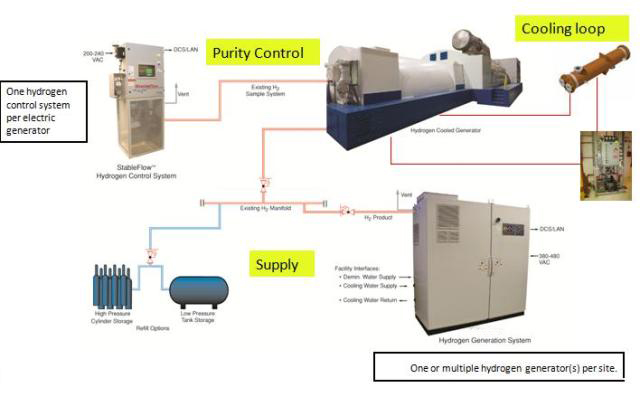Industry incidents forced MidWest Generation to conduct a multi-year program to review the safety risks associated with hydrogen storage at its Joliet IL Power Plant. The following were the problems identified at the site:
- Plant configuration changes
- Crowding at plant sites
- Required room for new scrubbers and other equipment
- Harmful materials standard changes
- Joliet #6 site identified as non-optimum hydrogen storage situation.
MidWest Generation Joliet Power Plant
Total capacity of the site is 1,334MW net. Unit #6 is located on one side of Des Plaines river, while other coal units on the other side. Started operation in the late 1950’s, Unit #6 is a GE cross-compound unit with a capacity of 290 MW net. For Unit #6, hydrogen was supplied by means of tube trailer in dual-slot drop and swap configuration (Figure 1) and all hydrogen control systems were OEM original. Dryers were installed in the 1990-2000 timeframe and were out of service.
.jpg)
Figure 1. Stored Hydrogen-Tube Trailer Delivery System at Unit #6.
The stored hydrogen-tube trailer delivery system at Unit #6 was positioned close to process units and high speed public rail line. The site was challenged with hydrogen delivery as it was difficult to maneuver the trailer into place. In addition, plant space required for units for emissions compliance and other processes. Local supplier means easy to get trailer for regas if and when needed.
Improvement Opportunities at Joliet Power Plant
.jpg)
Figure 2. H Series Hydrogen Generator.
The Joliet Power Plant selected H Series hydrogen generators (Figure 2) as optimum plant approach. Using these generators, the plant eliminated the need for hydrogen fixed storage, thereby brining in delivered gas when required for regas. Moreover, the generator eliminated the necessity to move gas storage for safety, reduced plant piping and civil investment, and eliminated project cost and disruption in plant operations. The H Series generator connected to existing piping. Hydrogen system layout at the power plant is shown in Figure 3.

Figure 3. Power Plant Hydrogen System Layout.
Advantages of H Series Hydrogen Generator
The H Series hydrogen generator supplies hydrogen at near-zero variable cost. Low pressure hydrogen at limited flow rate is safer, reducing risk of release and accumulation. The new generator has brought in a continuous scavenge approach in place of former bleed and feed hydrogen addition. The new system offers several benefits, including plant safety, personnel productivity, less time spent adjusting, stable pressure, and higher purity.
Reason for Selection of StableFlow Hydrogen Control System
Both generators at Joliet #6 had hydrogen dryers, but they were out of service. Existing hydrogen control panels were old and semi-functional, with no dew point control system. Hence, the plant selected StableFlow hydrogen control system (Figure 4), which eliminated the requirement for hydrogen control cabinet replacement and dryer repairs.
.jpg)
Figure 4. StableFlow Hydrogen Control System.
Joliet #6 had OEM original hydrogen purity, pressure and dew point control systems, with a average purity of 99.3% and average pressure of 26 psig. The systems were people-intensive manual control and usually ran un-optimized. StableFlow hydrogen control can complement or replace OEM Hydrogen Control Cabinet, with optimized hydrogen purity, dew-point and pressure.
The StableFlow hydrogen control system reduces dew point, optimizes pressure for full capability, and drives up purity to lower windage loss. Set-point can be adjusted easily, making precise seasonal pressure adjustments possible and profitable for optimum windage/capability point. Proton analysis showed the possibility of improving hydrogen control.
The use of advanced feedback system in place of legacy manual instruments allowed for automation and more precise control, thereby optimizing operation with improved average purity of 99.5% and average pressure of 26.5 psig. The hydrogen pressure and purity at the Joliet Power Plant is shown in Figures 5, 6 and 7.
.jpg)
Figure 5. Joliet Hydrogen Pressure and Purity.
.jpg)
Figure 6. Joliet Hydrogen Pressure and Purity.
.jpg)
Figure 7. Joliet Hydrogen Pressure and Purity.
Joliet Windage Loss Savings
Estimations need to be refined based on actual numbers from analysis of historical data. One percentage of purity improvement on a 600 MW generator delivers 250 kW drag reduction. Hence, if the increase in the average purity at the Joliet Power Plant is 1%, then it is possible to reduce drage for the total of the two units by 125 kW or 3 MWh per day, which translates to roughly $120 per day or $44,000 per year.
Benefits of H Series Hydrogen Generator
The following are the benefits of the H Series hydrogen generator:
- Minimize on-site hydrogen inventory
- Minimize personnel involvement with hydrogen
- Allow for safe continuous scavenge
- Lower hydrogen costs
- Achieve NFPA compliance while reducing infrastructure investment.
Benefits of StableFlow Hydrogen Control System
The following are the benefits of StableFlow hydrogen control system:
- Improve purity to save fuel and minimize emissions by lowering windage loss
- Optimize pressure control to ascertain full generator capability
- Achieve compliant dew point without dryer operation
- Automate purity, pressure and dew point control, minimizing operator diversions.

This information has been sourced, reviewed and adapted from materials provided by Nel Hydrogen.
For more information on this source, please visit Nel Hydrogen.